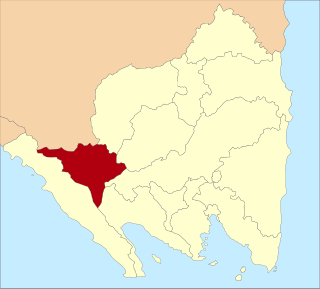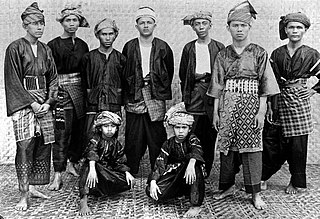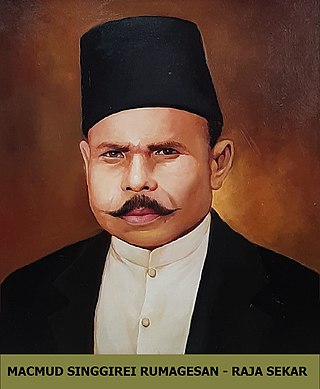
The Dayak or Dyak or Dayuh are one of the native groups of Borneo. It is a loose term for over 200 riverine and hill-dwelling ethnic groups, located principally in the central and southern interior of Borneo, each with its own dialect, customs, laws, territory, and culture, although common distinguishing traits are readily identifiable. Dayak languages are categorised as part of the Austronesian languages. The Dayak were animist in belief; however, since the 19th century there has been mass conversion to Christianity as well as Islam due to the spreading of Abrahamic religions.

Lampung, officially the Province of Lampung, is a province of Indonesia. It is located on the southern tip of the island of Sumatra. It has a short border with the province of Bengkulu to the northwest, and a longer border with the province of South Sumatra to the north, as well a maritime border with the province of Banten to the east. It is the original home of the Lampung people, who speak their own language, and possess their own written script. Its capital is Bandar Lampung.

The Banjar or Banjarese are an indigenous ethnic group native to the Banjar regions in the southeastern Kalimantan regions of Indonesia. Nowadays, Banjarese diaspora can be found in neighbouring Banjar regions as well; including Kotabaru Regency, the southeastern regions of Central Kalimantan, southernmost regions of East Kalimantan, and some provinces of Indonesia in general. The Banjarese diaspora community also can be found in neighbouring countries of Indonesia, such as Brunei, Malaysia, and Singapore.

The Salakanagara Kingdom is the first historically recorded Indianised kingdom in Western Java. The kingdom existed between 130-362 AD. Claudius Ptolemaeus wrote about Java in his book, Γεωγραφικὴ Ὑφήγησις. He mentions the lands of Chryse and Argyre in Labadio. According to some historians, e.g. Edi S. Ekajati, Labadio means Dwipa-Javaka, Dwipa-Javaka or Java Dwipa, which is the ancient name of Java Island. At the time, the Salakanagara kingdom ruled west Java and its name means “Silver Nation” in old Sundanese language. According to some theories, Ptolemaeus may have visited Java in 160 AD. A more recent source, from the 17th century, Pustaka Rajya Rajya i Bhumi Nusantara describes Salakanagara as being founded by an Indian merchant from Pallava Kingdom.
Udo Z. Karzi is an Indonesian writer.

West Lampung Regency is a regency of Lampung Province, Sumatra, Indonesia. Until 2012 it had an area of 4,950.4 km2 of which forests occupied some 57% of the total area. It had a population of 418,560 people at the 2010 census. However, on 25 October 2012 the southwestern part of this area was separated from West Lampung Regency to form the new Pesisir Barat Regency.

Tanggamus Regency is a regency (kabupaten) of Lampung Province, Sumatra, Indonesia. It has an area of 4,654.96 km² and had a population of 534,595 at the 2010 Census and 640,275 at the 2020 Census; the official estimate as at mid 2022 was 652,898. The regency seat is the town of Kota Agung Pusat. The regency was created on 21 March 1997, but districts in its eastern part were split away on 29 October 2008 to form a new Pringsewu Regency. It lies in the southwest of the province, and surrounds Semangka Bay on its west, north and east coasts.

Tulang Bawang Regency is a regency (kabupaten) of Lampung Province, Sumatra, Indonesia. The regency was created on 3 January 1997 from the eastern half of North Lampung Regency; when created, it originally covered a much wider area, but on 29 October 2008 the 7 northern districts were separated off to form a new Mesuji Regency, and the 8 western districts were also separated off to form a new West Tulang Bawang Regency. It now has an area of 3,466.32 square kilometres (1,338.35 sq mi) and had a population of 430,021 at the 2020 Census; the official estimate as at mid 2022 was 431,208. The regency seat is the town of Menggala, located about 120 kilometres (75 mi) from the provincial capital of Bandar Lampung. The regency takes its name from the Tulang Bawang River which flows through the province.

Tana Tidung Regency is a regency within the Indonesian province of North Kalimantan. It is Indonesia's least populous regency, with 25,584 inhabitants recorded in the 2020 census; the official estimate as at mid 2022 was 27,571. Its regency seat is the town of Tideng Pale, in Sesayap District, where 11,280 of the regency's population lived in mid 2022.

Pesisir Barat Regency is a new regency in Lampung Province of Indonesia. It was created on 25 October 2012 from the eight western districts of West Lampung Regency. It covers an area of 2,907.23 km2, and had a population of 141,741 at the 2010 Census and 162,697 at the 2020 Census; the official estimate as of mid-2022 was 164,816. The administrative center is the town of Krui. The majority group in the Pesisir Barat Regency is the Lampung people.
Liwa is the capital of West Lampung Regency, Lampung province, Indonesia.

Sumedang Larang is an Islamic Kingdom based in Sumedang, West Java. Its territory consisted of the Parahyangan region, before becoming a vassal state under the Mataram Sultanate.

The Lampung or Lampungese are an indigenous ethnic group native to Lampung and some parts of South Sumatra, Bengkulu, as well as in the southwest coast of Banten. They speak the Lampung language, a Lampungic language estimated to have 1.5 million speakers.

Tengkolok, also known as Tanjak, Destar is a traditional Malay or Indonesian and male headgear. It is made from long songket cloth folded and tied in a particular style (solek). Nowadays, it is usually worn in ceremonious functions, such as royal ceremonies by royalties, and wedding ceremonies by grooms.

Machmud Singgirei Rumagesan was a king of Sekar and pro-integration activist from West Papua. He founded the movement Gerakan Tjendrawasih Revolusioner Irian Barat (GTRIB) in 1953, and became the member of Supreme Advisory Council in 1959. On 10 November 2020, Singgirei Rumagesan was posthumously declared a National Hero of Indonesia for his lifelong efforts to unite West Irian with Indonesia.
Abdul Qodir Hasan Baraja is an Indonesian cleric, and the founder and Caliph of Khilafatul Muslimin. He is a former Darul Islam activist, and Komando Jihad combatant which was active during late 1970s to 1980s.

Central Papua, officially the Central Papua Province is an Indonesian province located in the central region of Western New Guinea. It was formally established on 11 November 2022 from the former eight western regencies of the province of Papua. It covers an area of 61,072.92 km2 and had an officially estimated population of 1,430,951 in mid 2022. It is bordered by the Indonesian provinces of West Papua to the west, province of Papua to the north, and by Highland Papua and South Papua to the east. The designated administrative capital is located in Nabire Regency.

The Komering are an ethnic group that inhabits along the Komering River in South Sumatra province.

Lampung Cikoneng is a Lampung dialect originally from Lampung province. This language is spoken by the Lampung Cikoneng people who inhabit the areas Cikoneng village, Anyar district in Serang Regency.
The Tumi is the ancient language which was probably previously used by Tumi people besides Sanskrit. This language is thought to have become extinct in the 13th century after the entry of Islam to southern Sumatra and the assimilation of the Tumi tribe with other ethnic groups who currently form the Lampung people who speak the Lampung language.
















